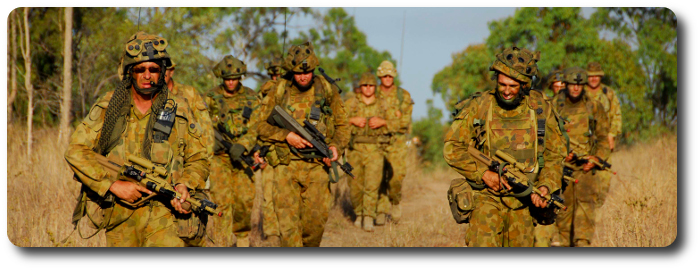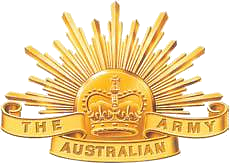Topic: Soldiers' Load

The Soldiers Load; Australia
A Review of the Soldier's Equipment Burden, Chris Brady, Derrek Lush and Tom Chapman; Land Operations Division, Defence Science and Technology Organisation, 2011
 Content of Load Carriage Ensemble (LCE)
Content of Load Carriage Ensemble (LCE)
All infantrymen were asked to describe the total number and volume of different items in their LCE. Some of these items were not present during the interview but the soldiers said there was little variation between missions for these items. As is typical, all soldiers had equipment packed for 72 hour operations.
It should be noted that since this data collection was carried out in 2006 some items that were not on SOP lists are now Government Furnished Equipment (GFE) and are issued to soldiers.
2.5.1 Amount of Water
The majority of soldiers carried two litres of water in their webbing (or Camelback™) and eight litres in their packs. There was some variation in this, with some carrying more. The total weight of 10 litres of water is 10 kilograms, plus the weight of the various water storage containers.
2.5.2 Amount of Ammunition
Typically F89 Gunners carried 800 linked rounds, of which 500 was carried on their webbing, the rest given to another soldier to carry or (occasionally) in their packs. Total weight of 800 linked rounds is 10.8 kilograms.
The most common volume of rounds carried by those using the F88 rifle was 210 rounds (seven magazines). A few Section Commanders plus others carried from one to seven additional magazines. All ammunition (except perhaps those carrying large additions) was carried in webbing. Total weight of 210 rounds is 3.5 kilograms.
2.5.3 Amount of Rations
The average amount of rations carried was 3 days' worth. The majority of soldiers broke down their ration packs. Typically only one meal and/or snacks was stored in the soldier's webbing, the rest was in the pack. When the ration packs are broken down some items are normally discarded (Forbes-Ewan, 2001). The items discarded are usually done so because the soldier did not want to eat them, and not specifically because they were considered too heavy. Combat rations typically weighs 1.8 kg per soldier per day when complete. Patrol rations (a.k.a. 'dehyd' rations) typically weigh 1.1 kg per soldier per day when complete.
Note that water must be carried in addition to the patrol rations to re-hydrate them. Total weight for three days of combat rations is 5.4 kilograms.
2.5.4 Issued but not Carried
All soldiers' loads are determined by a unit SOP list. Soldiers in this study were asked if there was any equipment on their SOP list that they regularly did not carry with them, and why. There was only a small amount of kit from the SOP list not packed (Table 6). The bayonet cannot be used by soldiers with the underslung GLA, so they do not carry it with them. Many soldiers do not carry their mess kit, since most rationed food can been prepared and eaten without it. Quite a number of soldiers reported not carrying their issued sleeping bag. If the weather is warm then no cold weather kit was packed. Often no spare uniform is packed if the soldier is to be away for only 72 hours.
2.5.5 Alternative Version of Issued Kit
Soldiers were asked if they replaced GFE with their own personally procured items. Table 7 has a list of all reported non-GFE carried. Many soldiers did not carry the issued sleeping bag because it was considered bulky and heavy. The preferred alternative was the Merlin Softie™ series of sleeping bags, which was considerably smaller and lighter, and reportedly offered the same (if not better) heat insulation.
Some used non-issued versions of the raincoats, though no reason was given for this. Many soldiers also used a Maglite™-brand torch instead of the issued utility torch. The Maglite was supposedly brighter, lighter and smaller than the issued torch. Many soldiers carried a Leatherman™ or some other utility knife. Ka-bar™ knives were often carried also.
2.5.6 Additional Kit Carried
Many infantrymen carried additional equipment; kit that is not on the SOP list. The most common was the bivvy bag, which is a weather-proof outer to the sleeping bag. Camelbacks were also used by the majority of soldiers. Some also carried umbrellas, gas bottles and burners for added comfort when in the bush.
Table 6: List of reported equipment not carried (left), replaced (middle), and in-addition to the SOP list (right)
| Issued but not Carried | Alternative Version of GFE | Additional Kit Carried |
| Bayonet | Cam cream (alt type) | Bivvy bag |
| Cold Weather Uniform | Gun oil bottle (larger) | Caribena |
| Pan Mess Kit | Knife (combat) | Gas bottle & burner |
| Sleeping Bag | Knife (utility) | Pegs |
| Spare uniform | Mozzie Repellent | Torch (head light) |
| Towel | Raincoat | Umbrella |
| – | Softie sleeping bag (Merlin) | Plastic Entrenching Tool |
Some items were listed by soldiers as personal equipment but are now (or are soon to be) issued items. These include the Camelback and any additional water bladders, the Silva compass, the large (2 litre) water bottles and Maglite torches.
2.5.7 The Current Load
This report is not aiming to prove there is a soldier load carriage problem. The problem is so prevalent that no further proof is considered necessary; and previous studies have addressed this issue sufficiently (Knapik 2004; Allen & Vanderpeer 2007). Whilst there is no need to exhaustively list measured weights, and since the load distribution varies between Battalions, Platoons, and even soldiers, it will be useful to determine the average current weight for issues discussed in this report.
The weight of the equipment the infantryman must carry often exceeds 50 kg, but this has not always been the case. Knapik et al. (2004) reviewed data on the weights carried by soldiers throughout history. It is clear that the modern dismounted infantryman must carry a weight greater than soldiers in past conflicts. Part of this increased weight is because there is reduced auxiliary transport so the soldier must carry their own equipment. In fact, a key advantage of the dismounted infantry is that they can penetrate where support vehicles can't follow.
Load weight has also increased as the capability of the soldier has increased; the soldier can now do more by utilising new equipment previous generations of soldiers did not have access to. However, it is likely that the equipment burden has now increased to the point where capability is compromised. As Paulson (2006 p.81) notes; 'the weights carried at the moment are incongruent with the notion of manoeuvre warfare'.
Numerous studies have reported the weight carried by soldiers from various countries in different conflicts. The results of this survey are compared to previous studies in Table 7. It is important to acknowledge that the weights carried changes over time as food is consumed, water drunk and ammunition used (especially during training). As such a full load does not remain full for long and weights quoted are often full loads.
Table 7: The Weight (in kg) of Soldier Equipment by survey
| Load-out | Description | Duration worn | SOP (2) | Land 125 SOP (3) | Survey (4) | ||
| averaged* | Rifleman | Gunner | Rifleman | Gunner | |||
| Light Patrol | Webbing Only | 8 hr | – | 24.9 | 38.3 | – | – |
| Patrol Order | Webbing & Day Pack | 8-24 hr | 37.7 | 34.7 | 48.1 | – | – |
| Marching Order | Webbing & Field Pack | 24-72 hr | 60.2 | .9 | .3 | 46.0 | 57.0 |
*averaged over the section
(2) – 2 litres of water for patrol order. 4 litres of Marching order (though 3 days rations and ammo).
(3) – 8 litres of water for marching order. 4 litres for patrol order. 2 litres for light patrol order. From the Land 125-01-02 (MAR 02).
(4) – Includes typical load: Pack webbing and contents. 10 litres water, 3 days rations, front line ammo & weapon Excludes section and platoon level equipment: radios, med kits, batteries, GPS, binoculars & NVG.
In summary, although there is some difference between soldier roles and operations, in general it is likely that 55 kg is typical.

